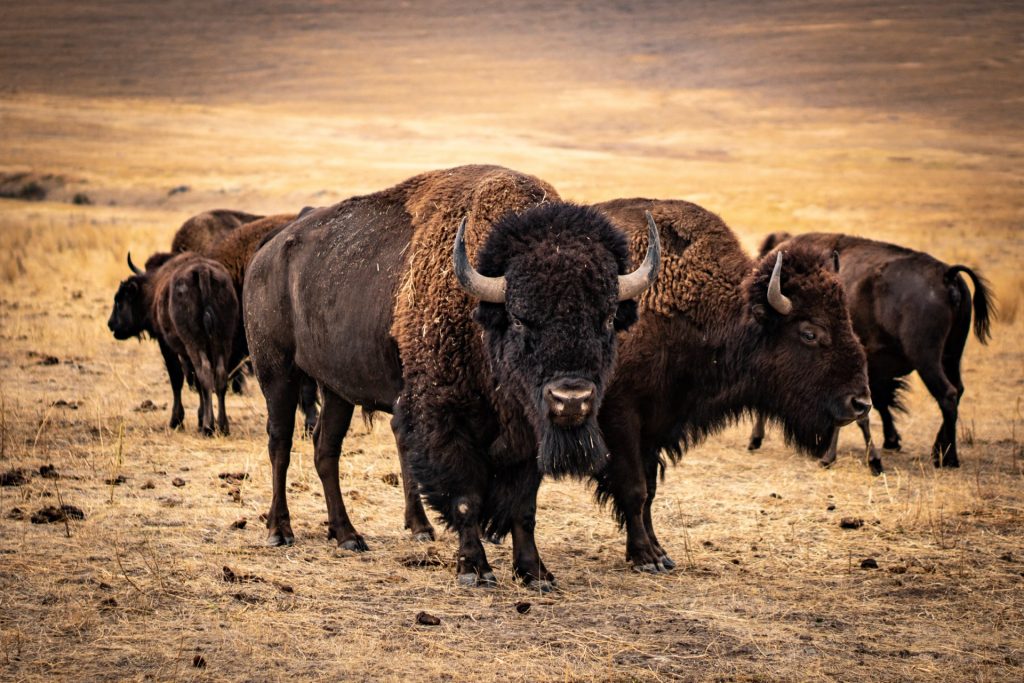The American bison is a spectacular creature. As the largest mammal in North America, with males standing 6 feet tall and weighing up to 2,000 pounds, it’s no wonder they were the principal food source of choice for many Indigenous tribes (particularly the Indigenous People of the Plains) throughout what is now the United States and Canada. An integral part of Tribal culture, the American bison meant more than just food to Native Tribes – every part of the animal was put to use for fuel, tools, clothing, shelter and spiritual rituals.

Native American tribes hunted bison on foot, often by orchestrating stampedes and driving up to hundreds of bison off cliffs. A single “hunt” could provide all of the food and raw materials a tribe required for an entire year. Before European Americans settled the west in the 1800s and killed hundreds of thousands of bison with the purpose of driving Native American tribes from their lands, it’s estimated that tens of millions of American bison roamed from coast to coast.
By the late 1880s, the great American bison was nearly extinct with its population decimated to less than 2,000. By 1905, estimates put that number as low as 500. After hunting bison in the Dakota Territory and spending a few years in the West, President Teddy Roosevelt returned to the East Coast with a change of heart on what is now the official mammal of the United States. In 1905 he formed the American Bison Society and kickstarted the restoration movement. Today, there are approximately 30,000 bison in herds on public and private land in North America – and another 400,000 head are raised as livestock for consumption. All in all, today the American bison represents “the worst animal genocide in history and the greatest recovery from the brink of extinction.”
The Original Bison Jerky: How Native Americans Used Bison Meat
Indigenous tribes in North America used every part of the buffalo and prized the tongues, livers, kidneys, hearts and testicles as delicacies and prime meat. The rest of the edible muscle was usually sliced along the grain into thin strips to be made into bison jerky. To preserve the spoils of their large annual hunts, tribes would lay the cut slabs of bison meat on racks and smoke the meat over a smoldering fire for hours or days, depending on the cuts and volume of bison. In the West, it was common for bison jerky to be pounded thin with chokecherries and then mixed with bison kidney fat – a mixture called pemmican – which was a preferred food source for long journeys or hunts.
Bison Jerky Today
As the European American pioneers further explored the West throughout the 1800s, hunting American buffalo became a popular sport and its meat an exotic treat for wealthier Americans. Buffalo tongue, in particular, was a delicacy sought after and served in the finest restaurants across the new and growing country. As the American bison dwindled, so did its popularity among non-native Americans.
Thanks to the herculean conservation efforts by the United States government and private groups over the past, the American bison is back. While bison will never again be plentiful enough to make it into wild game jerky, premium farm-raised bison meat makes the best bison jerky out there – without threatening the one animal that (dare we say) is even more American than the bald eagle.
—
Bison Jerky vs Buffalo Jerky
Ah, the never-ending saga of bison vs buffalo. Is it bison? Or is it buffalo? Some swear both are correct; others are sticklers for nuance and scientific classifications. So, are they the same thing or not? Find out once and for all.
Leave a Reply